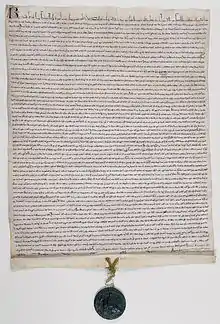Treaty of Paris (1229)
The Treaty of Paris, also known as Treaty of Meaux, was signed on April 12, 1229 between Raymond VII of Toulouse and Louis IX of France in Meaux near Paris. Louis was still a minor, and it was his mother Blanche of Castile who was responsible for the treaty.[1] The agreement officially ended the Albigensian Crusade (began 1209) as Raymond conceded defeat to Louis IX. Based on the terms of the treaty, Raymond's daughter Joan was to be married to Louis' brother Alphonse. Since Joan was Raymond's heir, this meant she and Alfonso would become the rulers of Toulouse on his death. Moreover, Raymond ceded the eastern provinces of his lands[2] to Louis and the Marquisat de Provence to the Pope.

The treaty marked the end of Occitan political autonomy. Raymond ceded more than half his land to the French crown and retained the remainder only during his life, after which it would be inherited by his son-in-law Alphonse, Louis' brother, or, if Alphonse had no heir (as he did not), by the French crown.[2] Raymond regained his feudal rights, but had to swear allegiance to Louis IX. Fortifications, such as those of Toulouse, were dismantled. The Cathars were left without political and military protection, as Raymond and his subordinates, now vassals of the French crown, were ordered to hunt them down.[2]
Notes
- Jackson, Guida, M. (1999). Women rulers throughout the ages: an illustrated guide. ABC-CLIO, Inc. p. 64.CS1 maint: multiple names: authors list (link)
- Claude Lebedel. Understanding the tragedy of the Cathars. Ouest France, 2011. p. 96f. ISBN 978-2-7373-5267-6.